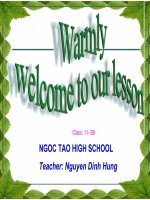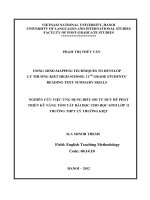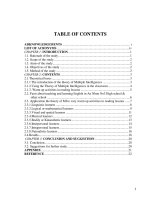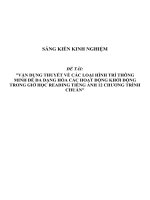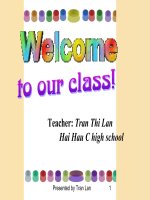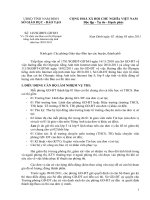Using information transfer techniques to exploit reading tiếng anh 12
Bạn đang xem bản rút gọn của tài liệu. Xem và tải ngay bản đầy đủ của tài liệu tại đây (461.12 KB, 32 trang )
TABLE OF CONTENTS
CONTENTS
1. INTRODUCTION
PAGES
2
1.1 Rationale
2
1.2 Aims of the study
2
1.3 Scope of study
3
2. CONTENTS
3
2.1 Theoretical background
3
2.2 Practical background
5
2.2.1 Suggested transformations for reading texts in “Tieng Anh
6
12”
2.2.2 Questionaire
19
2.2.3 Results
21
2.3. Effectiveness of the teaching experience
25
3. CONCLUSION
25
4. REFRENCES
27
1. INTRODUCTION
1.1.
Rationale
Teaching reading skills of English has been so far considered very important
in Vietnamese secondary school classes. However, the procedure of teaching a
reading text in English, especially the steps of exploiting content has not been
1
very satisfactory since they are limited to only some techniques and these
techniques are repeatedly used. Therefore, practicing the reading skill of English
as a foreign language is a matter of much concern by language teachers. In order
to make the lessons more exciting, creative and effective, to help students
acquirres language skills of English, new techniques should be applied and one
of them is information transfer.
This assignment deals with the information - transfer technique that aim to
help language teachers control the procudure of explaining content of a reading
text and checking students’ understanding efectively, and at the same time
involve students in challenging, meaningful and interesting activities of content
exploitation.
Examples presented here focus on the textbook of English 12 – new
version
1.2. Aims of the study
Reading is one of the important skills. Reading book can help the readers to
understand about something happens in this era, the past time or even prediction
of the future. Reading for defined compression, whether look for detailed
information or language, must be seen as something easy or difficult to do, it
will be easy to do if it has high reading interest. Reading is an important activity
in many languages class, not only as a source of information and a pleasurable
activity, but also as a means of consolidating and extending one’s knowledge of
the language. If a student cannot read and comprehend a written language, they
cannot be expected to be good in other content areas which will indispensably
require some reading ability.
According to Heilman et. al., reading comprehension is a process of
making sense of written ideas through meaningful interpretation and interaction
with language (1981). Teaching technique mean of achieving the learning goals
that they achieve depend on how effective and skillful the technique being used
2
(Nation, 1981). It is certain that every teacher has their own way of teaching
reading comprehension. The fact is that the methods for teaching reading have
subjected to substantial changes over time.
Information Transfer technique means translating data from one form to
another. We move from the reading or listening text to graphic stimuli, or visual
like charts, graphs, diagrams, figures, maps, etc and vice versa (Storla in Thi
and Loan, 2010). Furthermore, Widdowson states that the Information Transfer
technique is the “transformation of instances of discourses from one type into
another but these instances of discourse can also be derived from a non-verbal
mode of communicating (Widdowson in Thi and Loan, 2010)
1.3. Scope of research
The study deals with information transfer activities for the teaching or
using “ Tiếng Anh 12” at Ba Thuoc high school in Thanh Hoa province.
II. CONTENTS
2.1 Theoretical background
In order to help our students acquire the reading skills of English, according
to Nuttle, C, “the focus of interest in the reading lesson is neither language nor
content, but the two together: we want our students to learn how language is
used for conveying content, we want them to develop the skills needed to extract
the content from the language that expresses it. These are the skills they need in
order to become effective independent readers”
(Nuttle C. 1982.31)
Commonly in the context of teaching comprehension in secondary school
classroom of English, there are only a few techniques that are being repeatedly
used to study content of a reading text such as:
Question – answer
Finding synonyms / antonyms
3
Gap – filling
True – false
Of the four common techniques, the questions – answer technique is the
most preferred one. Language teachers usually employ these techniques after
dealing with vocabulary and structure study. The purpose is to assist student’s
comprehension of ideas in reading texts. These techniques satisfy the purpose in
some ways. However, if these techniques are repeatedly used in all reading texts,
the procedures become monotonous. We will find it difficult to enliven the
teaching atmosphere and students are hardly interested in their lessons.
I myself sometimes use the summary technique to satisfy this purpose but
through class observations, this technique turned out to be unsuccessful since
students’ writing skills left much to be desired and they find it difficult to
practise the summary skill.
The information – transfer technique, with most main information in a
reading text being transferred into its variety of structures (charts, graphs, maps,
outlines, tables, etc.) and with pair / groupwork – based interaction, will help
teachers and students deal with the overall image of a paragraph, paragraphs and
of the whole text; make the activities competitive and at the same time
encourage students’ involvement in the lesson. The teaching procedure is
therefore enriched with challenging, demanding yet exciting activities.
We can design a diagrammatic form that summarises main ideas of one or
more than one paragraph, or a whole text for the step of content reproduction,
consolidation, or summary. With a diagrammatic form presented on a poster,
which includes most main ideas of the passage studied, the teacher may model
by reproducing the ideas on the form verbally and then invite students to do the
reproduction. The reproduction should be divided into parts if the diagrammatic
form includes many details.
4
Experience shows that if the diagrammatic form is clear and beautiful and
the reproduction is not so complicated, students may be very willing to
participate. While doing the reproduction, they can use their own grammar,
instead of merely sticking to the language in the passage, to connect all the
details on the form and practise their speaking skill in an effective way. This step
should be introdured in the content study stage, after finishing one or two
activities in the stage such as a question – answer activity or a true – false
exercise as it aims to strengthen and consolidate students’ understanding of a
reading text in a global and thorough way.
We may also use information – transfer activity to check or test students’
ability to understand the content of a passage. That is why this activity should
be introduced at the end of the content stage. The teacher may design a
diagrammatic form including most main ideas in a reading text. But instead of
providing all information on the form, we will leave some blanks for students to
complete. We may use the poster sticking on the board or handouts for groups.
An overhead transparency can be used instead of a poster, which can make the
activity more challenging and interesting due to the timing control. Checking
and giving feedback can be done right after that.
2.2 Practical background
The reasons affecting the effectiveness of a reading period in EFL
classrooms lie in the teachers and the students themselves. Besides, the reading
section in the book “Tieng Anh 12” also causes difficulties for both teachers and
students in teaching and learning process.
As for the teachers, although they are aware of the fact that teaching
reading skill is not easy and the reading section in the textbook is sometimes not
appropriate for students’ levels, they do not often adapt given tasks. Many of the
teachers just follow the requirements of the textbook without making any
changes to any of the tasks. In addition, there are many problems the teachers
often encounter when designing and carrying out activities for a reading lesson
5
such as limitation of time for preparation and for curriculum, students’ levels,
students’ background knowledge or lack of teaching facilities and teaching aids,
etc. All of these factors, to some extent, discourage the teachers from spend time
creating effective activities for a reading lesson.
For students, the main problem in learning reading is that they cannot
understand a reading task themselves without the help of the teachers. Their lack
of background knowledge and vocabulary prevents them from completing the
given tasks. These causes make many of the students feel bored with learning
reading skill and consider it a very difficult skill to master.
The reading section in the book “Tieng Anh 12” itself has some
inappropriateness for the success of a reading lesson in particular context of
teaching and learning. First, some of the topics are not familiar with the
students. There are still many new words in the tasks. And the requirements of
some reading tasks are out of students’ levels. Moreover, many of the reading
lessons cannot be completed in a period of 45 minutes.
In one word, it is undeniable that there still exist the problems originated from
the teaching and learning process in reality mentioned above. However, these
problems can be solved to make the reading section easier for both teachers and
students by applying the techniques of information transfer made by the
teachers’ flexibility.
2.2.1 Suggested transformations for reading texts in “Tiếng Anh 12”
The followoing activities base on the reading texts of “ Tiếng Anh”
(NXBGD 2008).
Unit 1:
HOME LIFE
Teacher hangs on the poster with this diagram or shows it on the overhead
transparency and then asks students to reproduce the text. T may use his/ her
grammar to reproduce a small part such as: “My family has 5 people. My father
is a biologist and he is very busy. However, he still tries to spend as much time
6
with children as possible. He also gives hand with housework such as cleaning
house or cooking.”
Teacher may devide the reproduction into 4 parts for easy practice; each
part talks about one member in family. And now is the time for students to
reproduce small parts and then the whole text. Teacher may provide help and
then let students state their work in front of the class.
MY FAMILY
Close – knit
supportive
Father: - A biologist -> busy
- Spend time with children
- Give hand with housework (cleaning house, cooking)
Mother: - A nurse -> busy
- Caring woman
- Run the household (get up early, rush to the market, and hurry home to
dinner …)
2 younger brothers:
- Active and mischivious
- Obedient and hard – working
I: - Eldest child and only daughter
- Final year at the secondary school
7
Unit 2: CULTURAL DIVERSITY
Americans:
Asians: (1)____
More concerned
concerned
Americans:
shares all thoughts
Asians: (3)_____
_________________
Physical attractive
(2) _____
Trust built
on love
(5)
_________
8
Americans:
Asians:
(4) ________
obliged to tell wives
If he comes home late
Americans:
equals
Asians: (6) ___
____________
Young Asians not as romantic as Americans
With this kind of diagram, students have to scan the text for the information
in the blanks.
Key:
1. less
2. confiding
3. unwise to confide in their wives
4. trust husband
5. partnership of equals
6. woman sacrifice more
We also can use this diagram for reproduction activity after complete the
blanks. Begin with “Due to cultural diversity, Americans and Asians have
different attitudes toward love and marriage, expressing on four key values. The
first one is …”
Unit 3: WAYS OF SOCIALISING
9
Verbal
communication
To attract one’s
attention
Non – verbal
communication
Whistle/ clap
Waving: most common
way
Nod slightly
Raise hand
slightly
Point at
Rude/ impolite
With this diagram, students can see the opposite ideas and summarize the text
easily.
Unit 4: SCHOOL EDUCATION SYSTEM
Education system
Compusory
- Age: (1) ______
- End: G.C.S.E
10
(2) ______
- From: (3) _______
- 3 terms: spring, autumn, and summer
Separated: (4) ______ : half term
State: - free
- 93% pupils
Systems
- 2 levels: (5) _______
- (6) ______: set by government
Independent: - fee – paying
Keys:
1. 5 to 16
4. one – week break
2. academic year
5. pimary and secondary
3. September to July
6. curriculum
11
Unit 5: HIGHER EDUCATION
Feel lonely
Sarah
Exciting:
- meeting people
- walking around campus
- go out with friends
- not have to explain to parents
Daunting
Ellen
First
IMPRESSION
of university life
Amazing
Scary
Get trouble with
roommates
Most challenging
Brenden
12
Enjoyed
Take part in projects
Make new friends
You
???
Unit 6: FUTURE JOBS
INTERVIEW
- find out about the job/ vacancy
- send letter of application and resumes
Before
- bring certificates and letters of recommendation
- jot down qualifications and experience
- be on time, dress neatly and formally
- concentrate
- try to answer
13
During
- be clear, polite, and honest
- admit weakness
- show enthusiasm, keenness, best side, and sense of
responsibility
After
-
think about comments
UNIT 8: LIFE IN THE FUTURE
modern
medical system
14
labour
saving devices
-
Economic
depression
Terrorism
Far better
Pessimists
Optimists
LIFE IN THE FUTURE
development
Technology computer
Telecommunication
Influence on
Work
Robots do most
Office
Go electronic
15
travel
car
electricity
methane
gas
space-shuttle
fitted with
computer
Never move in straight line
Be confident that future in our hand
Unit 10: ENDANGERED SPECIES
8.300
7.200
ENDANGERED SPECIES
Causes
- habitat destruction
- (1) ______
- (2) ______
- food
(3) ______
- clean air and water
- (4) ______
- many medicines and (5) ______
Conservation
- Made Red list
16
Help us,
please
zzzzzzzz!!!
Efforts
- (6) ______
- Established wildlife habitat
reserves
Keys:
1. commercial exploitation
2. pollution
3. benefits
4. fertile soil
5. other products
6. enacted laws
Unit 11: BOOKS
17
ADVANTAGES
VARIES
(2) ______
(1)
______
KEEP
FOREVER
18
(3) ______
Read bits
here & there
SWALLOW
Good
stories
CHEW &
DIGEST: (4)
______
Unit 13: THE 22ND SEA GAMES
Time
5th to 13th
December, 2003
Participants
Place
11 countries 32
sports
My Dinh Station, Ha
Noi, Viet Nam
The 22nd Sea
Games
Results: 444 gold
Spirit
medals
VN: 158
Thailand: 90
Indo: 55
solidarity& cooperation for peace &
development
VN’s preparation
Intensive programme
Strong support
19
Unit 15: WOMEN IN SOCIETY
Equal work oppotunity
Childbearing
homemaking
Intellectual ability
-> doubted
Equal pay to men
Past: limited
/ denied
Now:gained
significant rights
Right to vote
Educationn
Employmentt
Right to formal education
Legal / political rights
Unit 16: THE ASOCIATION OF SOUTHEAST ASIAN NATIONS
ASEAN
1967
Founded
1984
Brunei
1995
Viet Nam
1997
Laos & Myanmar
1999
Cambodia
Goals
+ accelerate: - economic growth
20
- social progress
- cultural development
+ promote peace & development
Population
575.5 million -> 8.7 % world’s population
Area
4.464.322 sp km
Features
- diverse cultures
- diverse economies
2006
Total trade: US $ 1405 billion
2007
GDP: US $ 1282 billion
2020
- free trade areae established
- ASEAN Vision -> closer economic intergration in region
improve socio-economic situation
solve problems among its member countries
2.2.2 Questionnaires
Questionnaires
21
1. What do you think the aims of the reading lessons are?
2. How important do you think reading lessons are?
a. very important
b. not very important
c. not important at all
3. Did you prepare the lessons before the class?
1. Yes, always.
2. Yes, sometimes.
3. No, never.
4. You have difficulties when learning reading skill because of the reasons…..
always
1 Difficutl topics
2 Lack of vocabulary
3 Long / complicated text
4 Your grammar is not good enough.
5 Your partner is not co-operative.
22
sometimes never
6 You have no ideas about the topics.
5. How do you find the following reading activites?
very difficult
not
very easy
difficult
1
T / F statements
2
Answer questions
3
Gap – filling
4
Finding
synonyms
/
antonyms
5
Discussion
6
Complete the chart
7
Oral reproduction
6. Did you participate in the oral reproduction actively?
1. Yes, always.
2. Yes, sometimes.
3. Seldom
4. No, never.
23
very easy
7. How much can you gain after reading lesson if using the information transfer technique to exploit the text? Tick one or more of the following or
you can add your own ideas.
1, the theme
2, a. all the main ideas
b. some of the main ideas
3, a. all the supporting details
b. some of the supporting ideas
c. not any of the supporting ideas.
Thanks for your help!
2.2.3 Results
Before applying these techniques of information transfer in reading texts in
“Tiếng Anh 12”, (school year 2016- 2017) most students think that, reading
lesons seem to be extremely difficult and boring.
Grade 12A6 (40 students) in the academic year of 2016 – 2017
good
Rather good
Average
Under average
Number
0
20
18
2
percentage
0
50%
45%
5%
Grade 12A7 ( 37 students) in the academic year of 2016 – 2017
24
good
Rather good
Average
Under average
Number
0
5
20
12
percentage
0
13,5%
54%
32,5%
In the school year 2017 - 2018, I used these information transfer techniques
in my teaching reading lessons, I realized that a numbers of students found
interested in learning reading increasing day by day. I collected students’ ideas
to know what they find about reading texts by some questions in the
questionnaires and had some replied information as below.
Most students stated that at first, they often read the text at home before
going to class but they still find it hard to summarize the main ideas of the
reading text because they lack of vocabulary and because the text is so long or
too complicated although they can find out the evidences to decide the
statements are true or false and answer questions in the text.
With class 12A6– a rather good at English class with 37 students, 27
students believe that the reading lessons are very important - containing 73 %,
10 students think they are not very important - containing 23 % and no one finds
they not important at all.
20 students in this class always prepare the lesson before class – containing 54
%, 13 students sometimes – containing 35 % and 4 students never prepare the
lesson before class – containing 11 %.
Through the questionaires, students also said that there are 3 main reasons
that make the reading texts become difficult. They are “lack of vocabulary,
long / complicated text and grammar is not good enough”. 7 students in this
class always lack vocabulary when learning reading skill – containing 18,9 %,
23 students sometimes – containing 62,1 % and 7 students never lack
vocabulary – containing 19 %.
25
